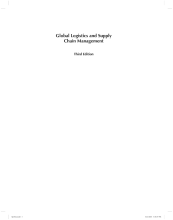Buying and selling in a complex world - Procurement step by step
35 important questions on Buying and selling in a complex world - Procurement step by step
What is a procurement planning and why is it important?
It is a condition for a succesfull implementation of projects, it gives transparency and predictability and it outlines the next 12-24 months of the procurements of the firm.
What does a good procurement planning require?
- Determine quantities and estimated costs
- When ready to use?
- Identify appropriate procurement methods to use
- Schedule lead times for each project
What kind of external stakeholders are there?
For example:
- The government
- Media
- Wider society
- Higher grades + faster learning
- Never study anything twice
- 100% sure, 100% understanding
Why are stakeholders important to organisations?
- Strong public and regulatory pressure
- Ethical and corporate responsibility frameworks.
What do stakeholders have the ability to influence?
- Quality
- Cost and pricing decisions
- Potential for innovation
- Control of strategic resources
What is supplier driven procurement?
What is buyer-driven procurement?
What is product-driven procurement?
What is market-driven procurement?
What are P2P activities?
What are the different types of enquiries when selcting a product?
2. RFP: Request for proposal
3. RFQ: Request for quotation
What does the request for proposal contain?
§Technical specifications
§Functional specifications
§expected service levels
§Purchase conditions
§Final reaction date
§Contact persons
What is the purpose of RFI?
-Extra info from the (potential) supplier
-Not all functionalities are known
-Supplier can show added value
-> request for information to benchmark (*) and to receive an indicative price.
What is the purpose of RFP?
- Coordinate extra info with internal partner.
- More specified request based on information obtained from RFI.
- Literally: “request for the best sales price and quotation”.
-The contacted supplier 'knows' that he may have survived the first selection round.
What is the purpose of RFQ?
- Specifications and functionalities are clear and understood.
- The supplier will respond with a complete and detailed offer.
- Price and contract conditions (*) can still be negociated.
- The contacted supplier 'knows' that he may have survived the second selection round.
What is the purpose of a contract?
What is a supplier assessment?
- Examine production methods and facilities
- To test the production
- Quality control procedure
- use of control charts
- Works in progress
- Policies and attitudes in relation to quality
What is important to the buyer and supplier when contracting?
Buyer: Terms and conditions to protect the buyer and govern the contract.
What are the different types of contract agreements?
- Framework agreement:
- Purchase goods and services
- Purchase goods
- Purchase services: Maintenance, catering, interim
What is an agreement framework?
What is volume pricing?
With which formula to calculate price differences?
What is the price increase?
145,6 - 140,2 = 5,4.
The percentage difference is then (5,4/140,2) x 100%
What is a letter of intent (LOI)?
Declaration of an intent to cooperate
Why?
Time savings to start (e.g. purchase of raw materials)
à Negociation phase has not been completed!
à No final signed / approved contract
What is a factory acceptance test?
The supplier informs the customer the machine is ready to be tested in “real life” conditions. To verify if everything works properly
What are the payment conditions in a contract?
10-25% when production of the machine is in course, or when the machine is ready for FAT.
- 20% after Site acceptance test
- 30% after final approval -> try to have this amount as high as possible
Meaning the machine works properly for some time (often 2 months) without unexpected or unvisual errors and breakdowns.
What is a purchase order form?
What other elements are hiding under the purchase price?
- Installation costs
- Financing costs,...
Why is it important to deliver all the goods on time?
What are box-to-box sales?
Supliers deliver goods in exactly the same box as it left the factory in the country of origin no extra
What is drop shipment?
1.a seller accepts an order from a customer,
2.places the order with a third-party supplier (a manufacturer or wholesale distributor)
directs the manufacturer to ship the goods directly to the customer.
How do warehouses check the quality of incoming goods?
§Goods are unacceptable
§Refuse to accept the batch
§Return the batch for replacement
§Return the batch for cedit
§Arrange for the supplier to make a 100% inspection at the buyer’s establishment to sort defective parts from good parts
§100% inspection, alternatives
§Return defective parts for credit or replacement
§Correct or rework defective parts
§Use the defective parts, but with special care or for special applications
§A lower price would be negotiated for the last 2 of these alternatives.
What do organisations have to monitor (follow-up) after the purchase?
- On quantity
- On quality
- On invoices
- Checking delivery dates
- Confirming backorders
How do organisations follow up performance? (Aftercare)
What steps are being taken if the supplier does not deliver the agreed SLA?
2. In writing
3. Action plan
4.Face-to-face meeting with supplier
5.Timescales
6. Procurement contract
What retentions and sanction are given when SLA are not being followed?
Sanctions: Retention, withold payment, litigation or termination of the contract
The question on the page originate from the summary of the following study material:
- A unique study and practice tool
- Never study anything twice again
- Get the grades you hope for
- 100% sure, 100% understanding






























